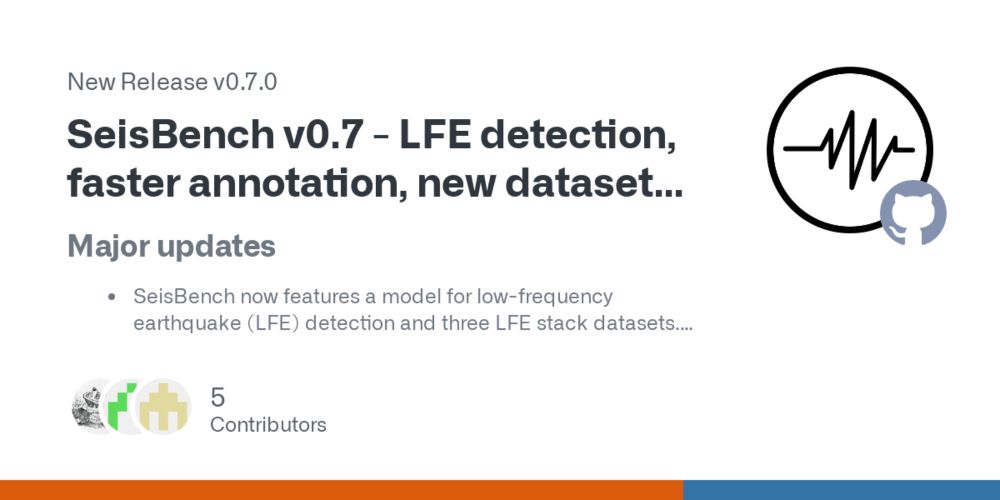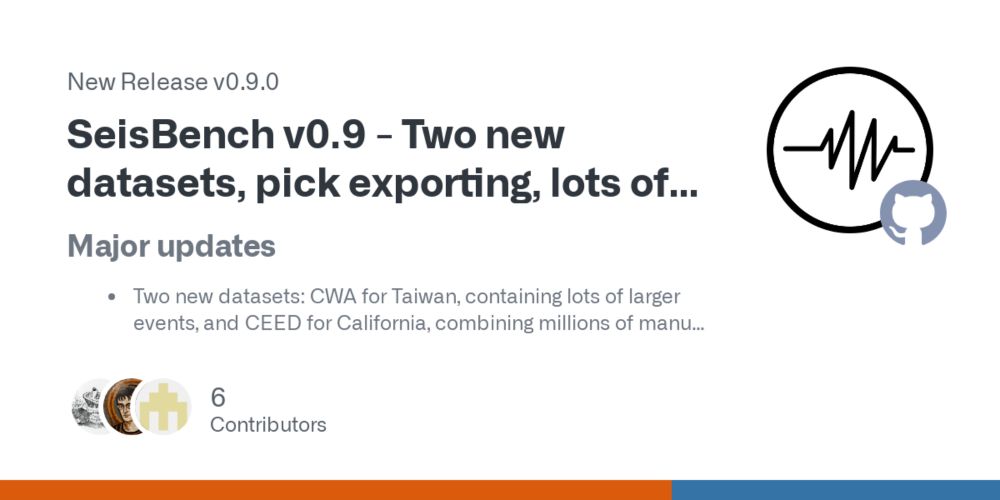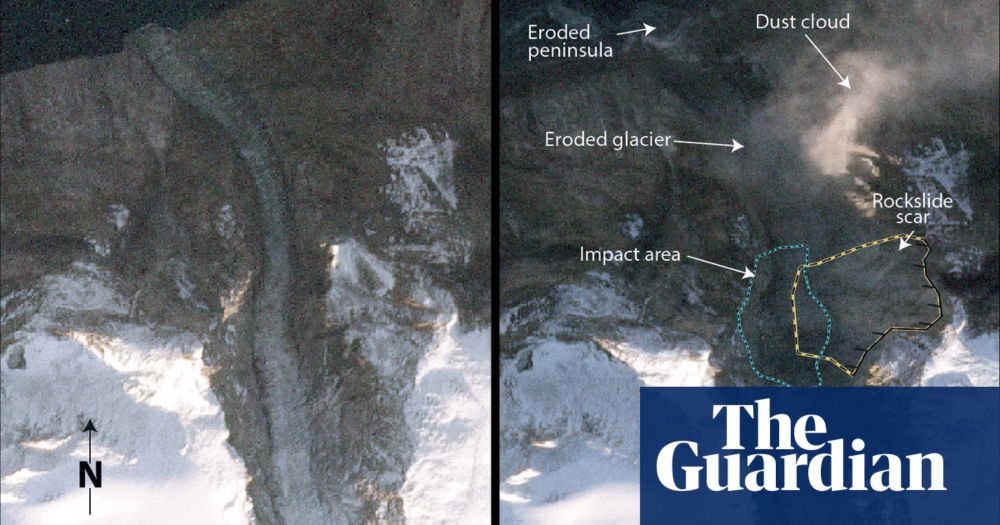
📈 Which seismic phase associator works best?
🧠Puente Huerta et al., benchmarked 5 algorithms testing their performance across diverse settings and under noisy-complex conditions
Read more: seismica.library.mcgill.ca/article/view...
------
@jannesmunch.bsky.social
01.10.2025 18:52 — 👍 1 🔁 3 💬 0 📌 0

Magma displacement triggered tens of thousands of earthquakes
Magma displacement triggered tens of thousands of earthquakes: Analysis of the swarm of earthquakes around Santorini in early 2025 reveals causes and development of the seismic crisis
Our latest study in Nature, together with colleagues from @geomarkiel.bsky.social and universities from Greece, shows what happened beneath Santorini earlier this year when tens of thousands earthquakes shook the islands and the seafloor. It was magma. We also have 1/2
www.gfz.de/en/press/new...
25.09.2025 12:10 — 👍 20 🔁 5 💬 2 📌 1
This is one of the most interesting sequences I've worked on so far! It's great to see how machine learning can provide us with these detailed images of seismicity in near real time. I'm glad to have been able to contribute to this project.
25.09.2025 08:25 — 👍 4 🔁 0 💬 0 📌 0

Introducing Xdas — a Python library designed to manipulate distributed acoustic sensing (DAS) data. #SRL ⚒️
pubs.geoscienceworld.org/ssa/srl/arti...
10.09.2025 02:01 — 👍 1 🔁 3 💬 0 📌 0
Congratulations on defending! That cake is truly outstanding! I never tried phase picking on my switch so far 😅
29.08.2025 14:51 — 👍 1 🔁 0 💬 2 📌 0
It should clearly read v0.10...
11.08.2025 15:40 — 👍 0 🔁 0 💬 0 📌 0
In addition, there are many smaller tweaks (pick export to Pandas, PhaseNetWC, ...). Thanks to all contributors of this release.
You're working on machine learning for seismology as well? SeisBench is always looking for new contributions!
14.05.2025 12:03 — 👍 1 🔁 0 💬 0 📌 0
The migrations hint at the processes causing SSE initiation on the plate interface. Looking back in time, we identify numerous seismic swarms exactly colocated with the 2023 swarm, suggesting the existence of recurring SSEs in the area. (2/2)
08.05.2025 09:00 — 👍 1 🔁 0 💬 0 📌 0

Overview figure of the 2023 SSE with three subplots. Left: The SSE slip model with seismicity overlain. Top right: zoom in on the onset sequence in map view. Bottom right: Cross-section of the onset sequence. In all panels, events are colored by time, revealing clear migtations.
Have you ever wondered how seismic swarms around slow slip events (SSEs) might work? In our recent work, we study the complex seismic migrations around the onset of a shallow SSEs in the Copiapó ridge in 2023. (1/2)
agupubs.onlinelibrary.wiley.com/doi/10.1029/...
08.05.2025 09:00 — 👍 1 🔁 1 💬 1 📌 0

A green and sunny landscape in southern Germany near the Austrian border photographed from a train.
Looking forward to a week full of science and networking at #EGU25! Join my talk on Thursday afternoon if you want to learn about the seismicity in Northern Chile and how swarms reveal the mechanisms of slow slip.
#Train2EGU
27.04.2025 12:27 — 👍 6 🔁 0 💬 0 📌 0

A flyer for the AI 4 Seismology International Training School, listing the data (05. to 08. May 2025) and location (Leipzig).
The registration for our International Training School for AI in Seismology is open now! The school combines lectures, poster sessions, practical tutorials, and networking opportunities.
We're looking forward to welcoming you in Leipzig in May!
10.03.2025 16:02 — 👍 5 🔁 0 💬 1 📌 0
This animation shows an example of how QSeek helps understanding the ongoing Santorini sequence in real-time: bsky.app/profile/gfz....
26.02.2025 12:45 — 👍 2 🔁 0 💬 0 📌 0
Our paper on QSeek is out in Seismica now. QSeek detects earthquakes and locates them precisely by backprojecting deep learning phase probability curves in time and space. And that at a blazingly fast speed! Thanks Marius Isken for this great work!
26.02.2025 12:45 — 👍 15 🔁 4 💬 1 📌 0
Just to clarify, I didn't make this animation. I made a similar one a few days ago: bsky.app/profile/jann...
Nonetheless, I fully agree that we need solid science funding to enable understanding hazards like this!
13.02.2025 15:59 — 👍 2 🔁 0 💬 1 📌 0
The main DEI page from @agu.org has been modified to take diversity out of the title. Glad to see it's not deleted entirely, but hey AGU, we're watching what you do and remembering the big game you once talked about supporting your diverse membership.
Today vs. January
10.02.2025 14:41 — 👍 460 🔁 148 💬 25 📌 47
Thanks! I've personally left Twitter, but you can share the material there. Please include the link back to the original Bluesky post.
10.02.2025 16:29 — 👍 4 🔁 0 💬 0 📌 0

Earthquake activity over distance along the transect. Both the large-scale migration and fine-scale burst migrations in both directions are visible.
Here you go! I picked a few of the burst migration speeds by hand and they are in the range of 2 km/h.
10.02.2025 15:23 — 👍 20 🔁 7 💬 4 📌 1
Hi Seismo-Bluesky! I decided to test a pipeline with SeisBench, PyOcto, NonLinLoc, and HypoDD on the Santorini sequence. The level of activity (>4,500 events) is truly stunning! There are repeated bursts migrating backwards and forwards, spreading outwards from a narrow, almost linear channel.
10.02.2025 13:23 — 👍 124 🔁 58 💬 5 📌 9

Advertisement for the AI 4 Seismology training school, showing a seismogram, the list of organisers, and the two confirmed speakers Tarje Nissen-Meyer and René Steinmann
🤖 Ready to use artificial intelligence to revolutionize seismology? Then join us at the International Training School "AI 4 Seismology" on May 5-8, 2025 at @scadsai.bsky.social in Leipzig.
So far confirmed trainers:
- Tarje Nissen-Meyer (@exeter.ac.uk )
- René Steinmann (@gfz.bsky.social )
09.02.2025 15:53 — 👍 8 🔁 4 💬 1 📌 2

20 years after the tsunami disaster
20 years after the tsunami disaster
Thanks to the GITEWS (now InaTEWS) early warning system developed under the leadership of the GFZ from 2005 to 2008, it is not only the Indian Ocean that is better ...
OTD twenty years ago the 3rd strongest earthquake ever recorded by seismometers struck offshore the island of Sumatra. A tsunami followed killing more than 200,000 people. In the aftermath we helped develop a tsunami warning system for the region. Read more here: www.gfz-potsdam.de/en/press/new...
26.12.2024 08:42 — 👍 22 🔁 11 💬 0 📌 1

Ready for #agu24. Come join our sessions on AI for solid Earth geosciences on Monday and Tuesday morning.
08.12.2024 23:30 — 👍 3 🔁 0 💬 0 📌 0
Great idea! Could you add me too?
14.08.2024 11:20 — 👍 1 🔁 0 💬 1 📌 0
Huge relief with the French election results! Really happy that I will not be living under a far-right government!
07.07.2024 21:15 — 👍 3 🔁 1 💬 0 📌 0

Low-frequency earthquakes are essential markers for understanding slow fault deformation.
Can we automatically detect them?
@jannesmunch.bsky.social et al. can, using their novel deep-learning detector that does not require prior knowledge of the region:
seismica.library.mcgill.ca/article/view...
10.05.2024 13:36 — 👍 6 🔁 1 💬 0 📌 0

Release SeisBench v0.7 - LFE detection, faster annotation, new datasets and models, ... · seisbench/seisbench
Major updates
SeisBench now features a model for low-frequency earthquake (LFE) detection and three LFE stack datasets. The model can be plugged into regular earthquake detection workflows just as...
SeisBench v0.7 is out with low-frequency earthquake detection, a wider variety of OBS detection data and models, new data from Texas, and the ability to pick a day of waveforms in less than 1 second. Check it out on Github!
Thanks to all contributors of this large feature release!
22.04.2024 11:27 — 👍 6 🔁 0 💬 0 📌 0
Geology - Plate tectonics - Mountain building - Paleogeography - Mantle motions - Paleomagnetism - Science communication - @GeoTdF.bsky.social - Professor at Utrecht University
Geophysicist at UT Austin working on the connections between planetary interior and surface systems. The physics of plate tectonics, from earthquakes to global mantle convection. Makes maps.
CNRS & Institut de physique du globe de Paris (IPGP).
Present and past Earthquakes, active tectonics, earthquake cycle, and anything related.
www.ipgp.fr/~klinger
PhD Candidate in Seismology
Oceanography x Seismology
Recherche, observation et diffusion des savoirs
#ENVIRONNEMENT #UNIVERS #TERRE
Fédère une communauté scientifique de 1400 collaborateurs
Full time scientist @ CNRS geology lab of ENS, Paris, France.
I study faults & earthquakes & tsunamis with space geodesy. Past and current work in South East Asia (Indonesia) and South America (Chile).
Seismologist.
NERC Independent Research Fellow and Lecturer at University College London (UCL).
https://profiles.ucl.ac.uk/89579-stephen-hicks
Seismologist. Geoazur lab.
Observatoire de la Côte d'Azur (OCA)
Université Côte D'Azur (UniCA)
France
Permafrost researcher and curious Arctic explorer, observer of rapid change. Spent some years in Alaska and Siberia, now at AWI Potsdam.
Gère le doctorat à l'Université Grenoble Alpes et fédère les 13 écoles doctorales thématiques.
Manages the PhD at the Université Grenoble Alpes and brings together the 13 thematic Doctoral Schools.
Seismologist, Continuous learner
https://github.com/claudiodsf
https://seismicsource.org
Compte officiel de l'Institut de physique du globe de Paris. Établissement d'enseignement supérieur et de recherche en sciences de la Terre, des planètes et de l'environnement, établissement composante d'Université Paris Cité.
Official account of the Cascadia Region Earthquake Science Center https://cascadiaquakes.org
Assistant Professor at the University of Alaska Anchorage | Structural Geology, Neotectonics, Paleoseismology, Seismic Hazard
















